2005 FORD F250 SUPER DUTY battery
[x] Cancel search: batteryPage 257 of 312
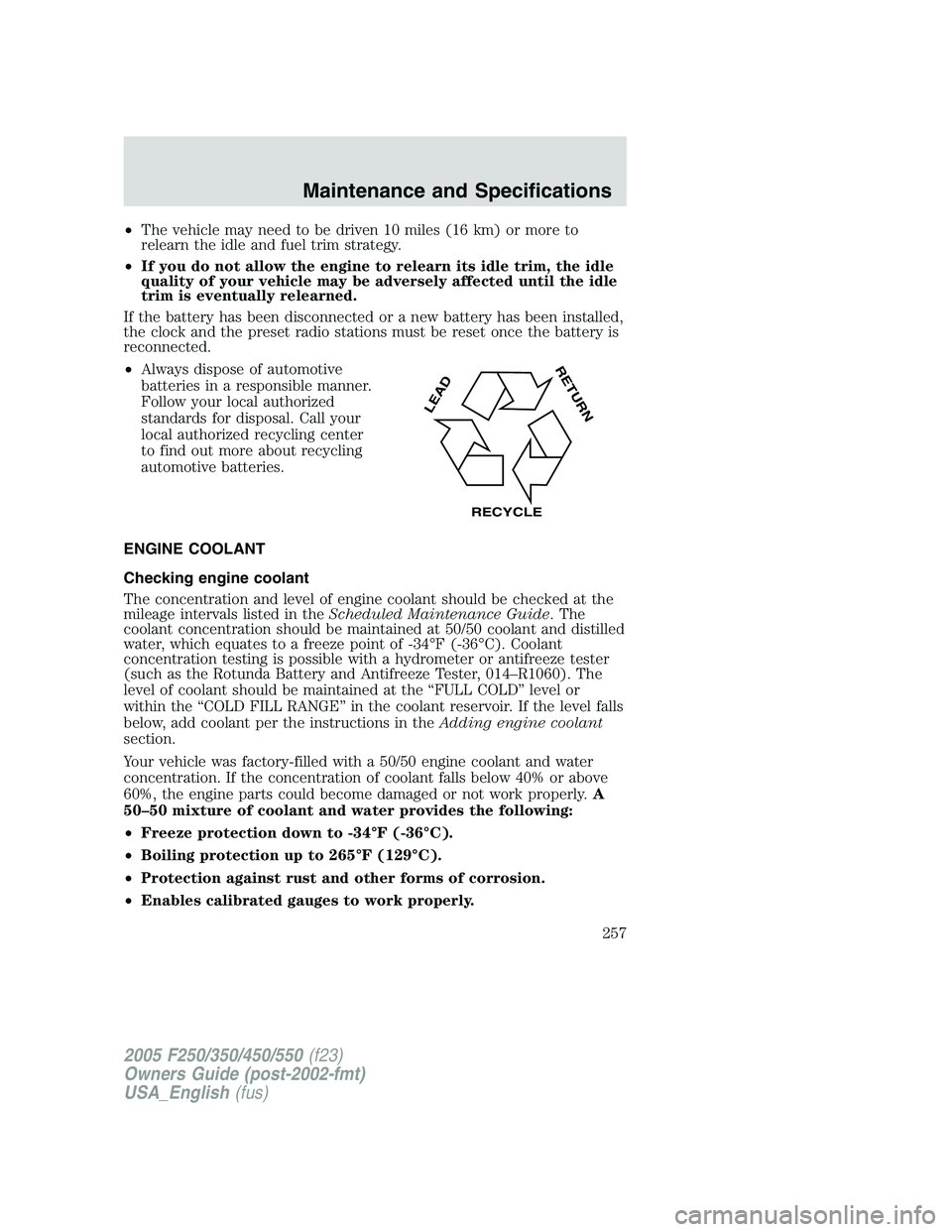
• The vehicle may need to be driven 10 miles (16 km) or more to
relearn the idle and fuel trim strategy.
• If you do not allow the engine to relearn its idle trim, the idle
quality of your vehicle may be adversely affected until the idle
trim is eventually relearned.
If the battery has been disconnected or a new battery has been installed,
the clock and the preset radio stations must be reset once the battery is
reconnected.
• Always dispose of automotive
batteries in a responsible manner.
Follow your local authorized
standards for disposal. Call your
local authorized recycling center
to find out more about recycling
automotive batteries.
ENGINE COOLANT
Checking engine coolant
The concentration and level of engine coolant should be checked at the
mileage intervals listed in the Scheduled Maintenance Guide . The
coolant concentration should be maintained at 50/50 coolant and distilled
water, which equates to a freeze point of -34°F (-36°C). Coolant
concentration testing is possible with a hydrometer or antifreeze tester
(such as the Rotunda Battery and Antifreeze Tester, 014–R1060). The
level of coolant should be maintained at the “FULL COLD” level or
within the “COLD FILL RANGE” in the coolant reservoir. If the level falls
below, add coolant per the instructions in the Adding engine coolant
section.
Your vehicle was factory-filled with a 50/50 engine coolant and water
concentration. If the concentration of coolant falls below 40% or above
60%, the engine parts could become damaged or not work properly. A
50–50 mixture of coolant and water provides the following:
• Freeze protection down to -34°F (-36°C).
• Boiling protection up to 265°F (129°C).
• Protection against rust and other forms of corrosion.
• Enables calibrated gauges to work properly.
L E A D
RETURN
RECYCLE
2005 F250/350/450/550 (f23)
Owners Guide (post-2002-fmt)
USA_English (fus) Maintenance and Specifications
257
Page 272 of 312
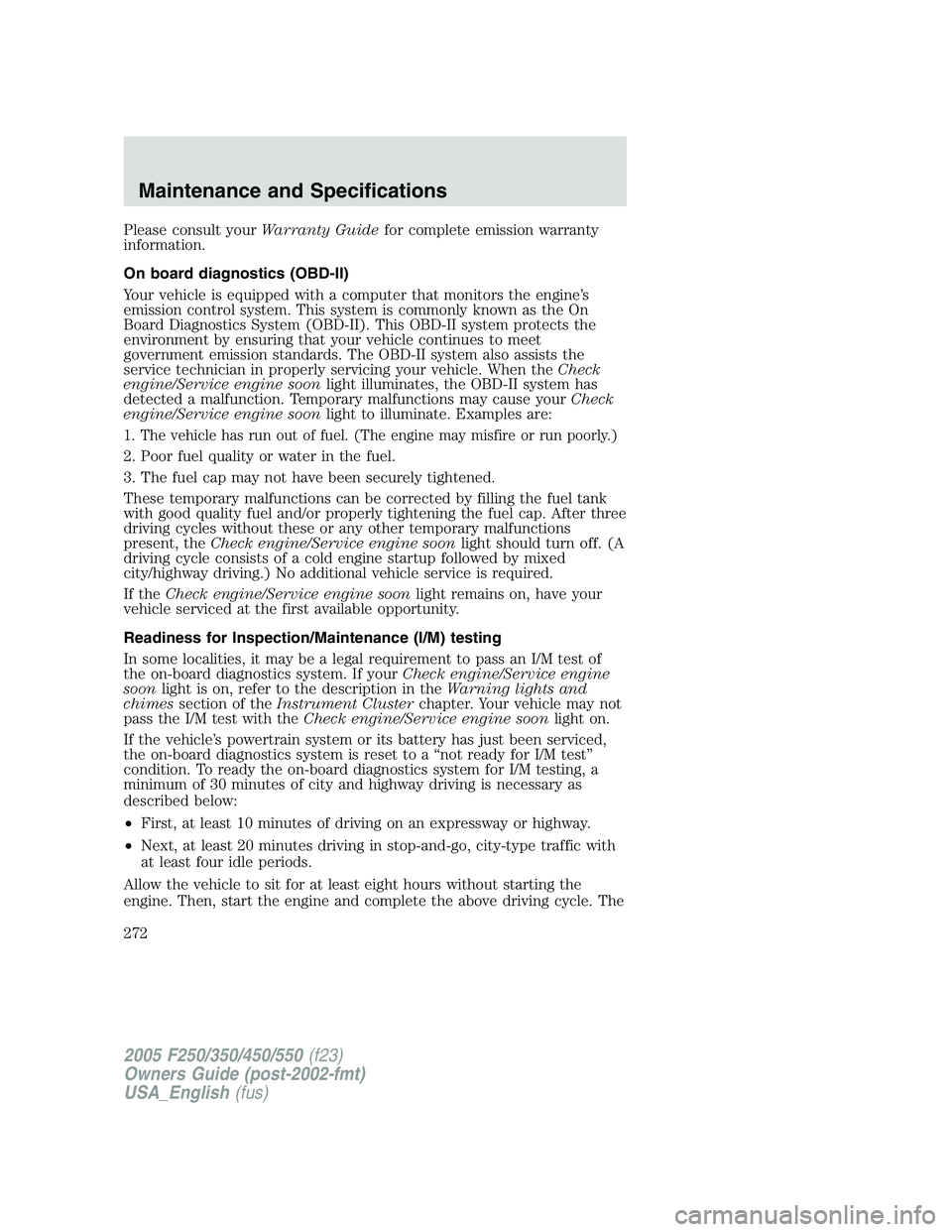
Please consult your Warranty Guide for complete emission warranty
information.
On board diagnostics (OBD-II)
Your vehicle is equipped with a computer that monitors the engine’s
emission control system. This system is commonly known as the On
Board Diagnostics System (OBD-II). This OBD-II system protects the
environment by ensuring that your vehicle continues to meet
government emission standards. The OBD-II system also assists the
service technician in properly servicing your vehicle. When the Check
engine/Service engine soon light illuminates, the OBD-II system has
detected a malfunction. Temporary malfunctions may cause your Check
engine/Service engine soon light to illuminate. Examples are:
1. The vehicle has run out of fuel. (The engine may misfire or run poorly.)
2. Poor fuel quality or water in the fuel.
3. The fuel cap may not have been securely tightened.
These temporary malfunctions can be corrected by filling the fuel tank
with good quality fuel and/or properly tightening the fuel cap. After three
driving cycles without these or any other temporary malfunctions
present, the Check engine/Service engine soon light should turn off. (A
driving cycle consists of a cold engine startup followed by mixed
city/highway driving.) No additional vehicle service is required.
If the Check engine/Service engine soon light remains on, have your
vehicle serviced at the first available opportunity.
Readiness for Inspection/Maintenance (I/M) testing
In some localities, it may be a legal requirement to pass an I/M test of
the on-board diagnostics system. If your Check engine/Service engine
soon light is on, refer to the description in the Warning lights and
chimes section of the Instrument Cluster chapter. Your vehicle may not
pass the I/M test with the Check engine/Service engine soon light on.
If the vehicle’s powertrain system or its battery has just been serviced,
the on-board diagnostics system is reset to a “not ready for I/M test”
condition. To ready the on-board diagnostics system for I/M testing, a
minimum of 30 minutes of city and highway driving is necessary as
described below:
• First, at least 10 minutes of driving on an expressway or highway.
• Next, at least 20 minutes driving in stop-and-go, city-type traffic with
at least four idle periods.
Allow the vehicle to sit for at least eight hours without starting the
engine. Then, start the engine and complete the above driving cycle. The
2005 F250/350/450/550 (f23)
Owners Guide (post-2002-fmt)
USA_English (fus)Maintenance and Specifications
272
Page 282 of 312
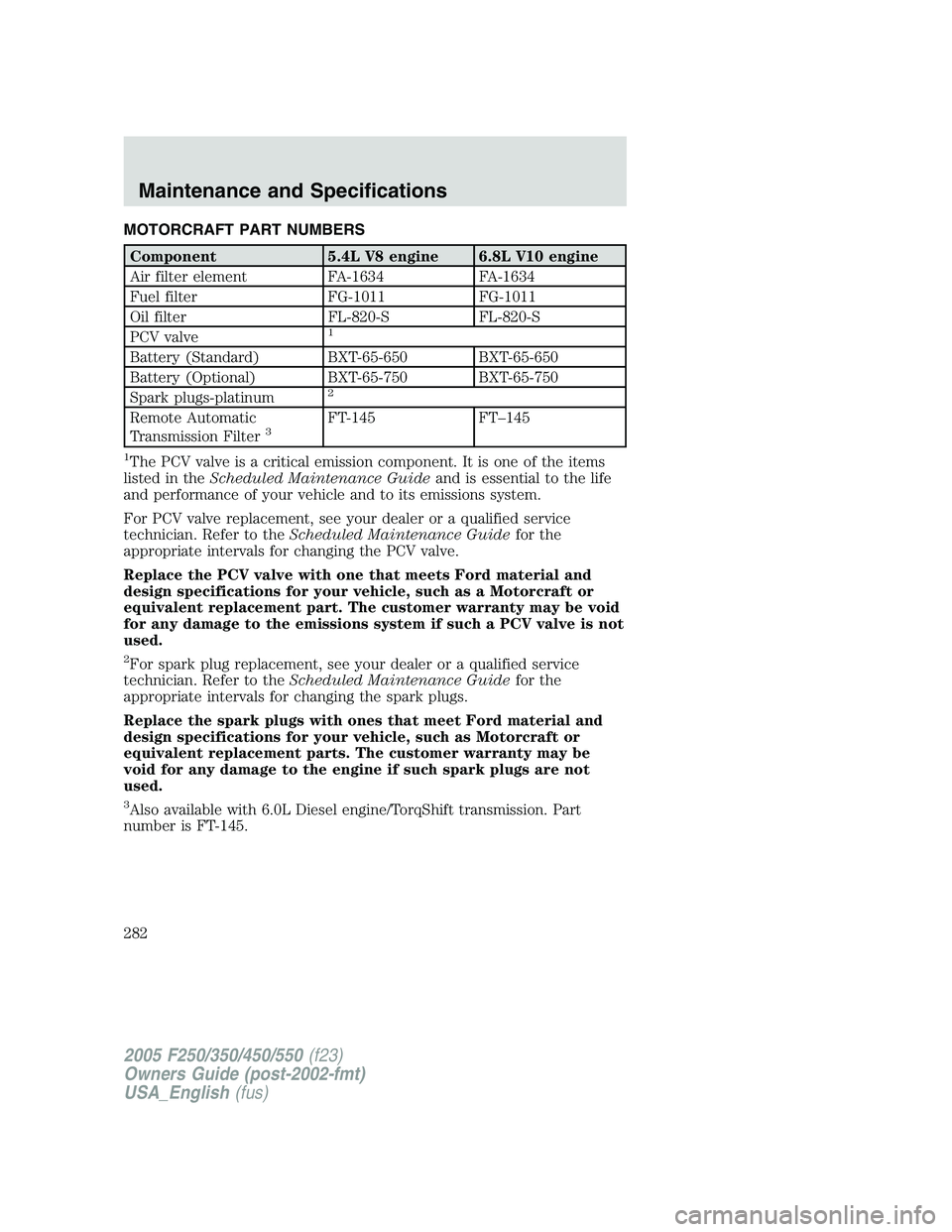
MOTORCRAFT PART NUMBERS
Component 5.4L V8 engine 6.8L V10 engine
Air filter element FA-1634 FA-1634
Fuel filter FG-1011 FG-1011
Oil filter FL-820-S FL-820-S
PCV valve 1
Battery (Standard) BXT-65-650 BXT-65-650
Battery (Optional) BXT-65-750 BXT-65-750
Spark plugs-platinum 2
Remote Automatic
Transmission Filter 3
FT-145 FT–1451
The PCV valve is a critical emission component. It is one of the items
listed in the Scheduled Maintenance Guide and is essential to the life
and performance of your vehicle and to its emissions system.
For PCV valve replacement, see your dealer or a qualified service
technician. Refer to the Scheduled Maintenance Guide for the
appropriate intervals for changing the PCV valve.
Replace the PCV valve with one that meets Ford material and
design specifications for your vehicle, such as a Motorcraft or
equivalent replacement part. The customer warranty may be void
for any damage to the emissions system if such a PCV valve is not
used. 2
For spark plug replacement, see your dealer or a qualified service
technician. Refer to the Scheduled Maintenance Guide for the
appropriate intervals for changing the spark plugs.
Replace the spark plugs with ones that meet Ford material and
design specifications for your vehicle, such as Motorcraft or
equivalent replacement parts. The customer warranty may be
void for any damage to the engine if such spark plugs are not
used. 3
Also available with 6.0L Diesel engine/TorqShift transmission. Part
number is FT-145.
2005 F250/350/450/550 (f23)
Owners Guide (post-2002-fmt)
USA_English (fus)Maintenance and Specifications
282
Page 301 of 312
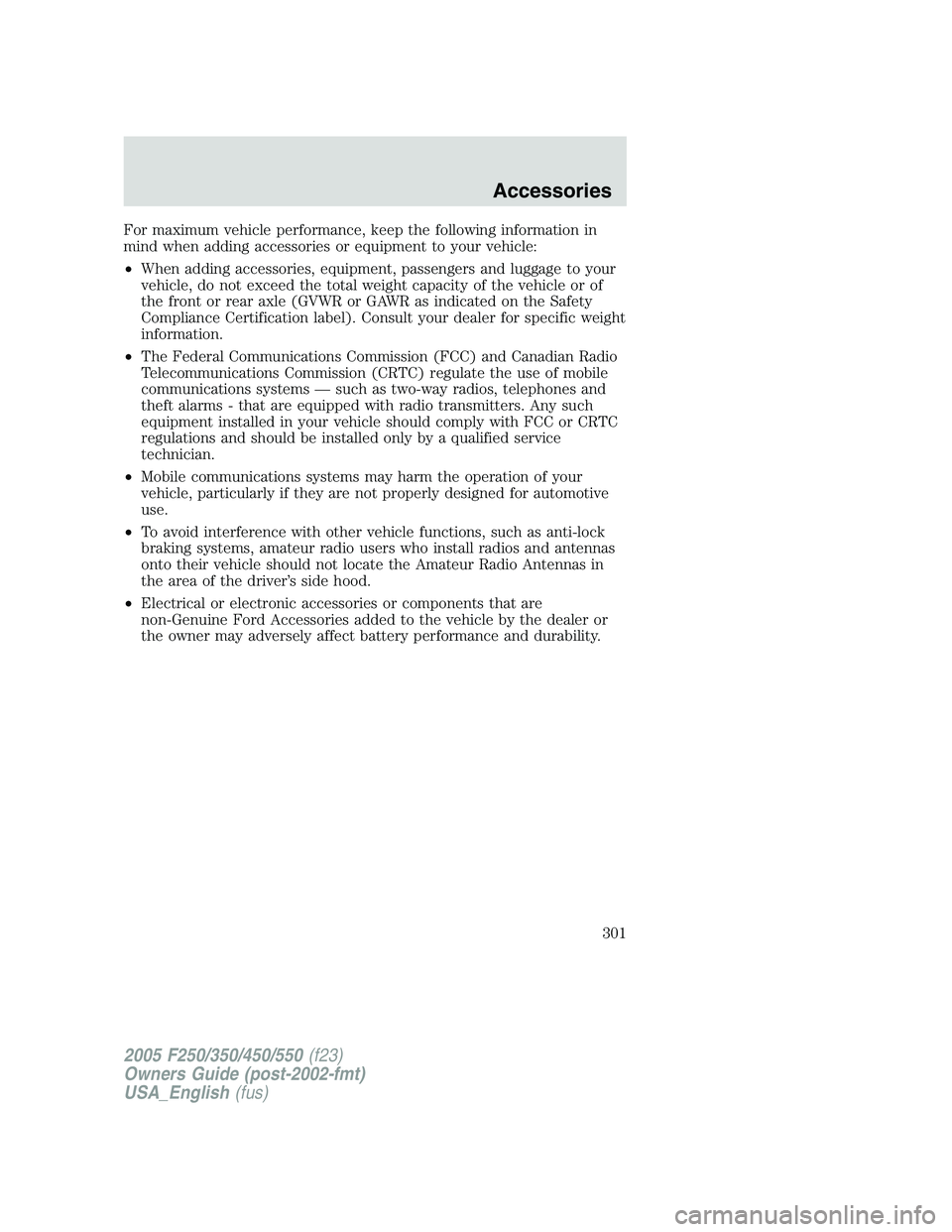
For maximum vehicle performance, keep the following information in
mind when adding accessories or equipment to your vehicle:
• When adding accessories, equipment, passengers and luggage to your
vehicle, do not exceed the total weight capacity of the vehicle or of
the front or rear axle (GVWR or GAWR as indicated on the Safety
Compliance Certification label). Consult your dealer for specific weight
information.
• The Federal Communications Commission (FCC) and Canadian Radio
Telecommunications Commission (CRTC) regulate the use of mobile
communications systems — such as two-way radios, telephones and
theft alarms - that are equipped with radio transmitters. Any such
equipment installed in your vehicle should comply with FCC or CRTC
regulations and should be installed only by a qualified service
technician.
• Mobile communications systems may harm the operation of your
vehicle, particularly if they are not properly designed for automotive
use.
• To avoid interference with other vehicle functions, such as anti-lock
braking systems, amateur radio users who install radios and antennas
onto their vehicle should not locate the Amateur Radio Antennas in
the area of the driver’s side hood.
• Electrical or electronic accessories or components that are
non-Genuine Ford Accessories added to the vehicle by the dealer or
the owner may adversely affect battery performance and durability.
2005 F250/350/450/550 (f23)
Owners Guide (post-2002-fmt)
USA_English (fus) Accessories
301
Page 302 of 312
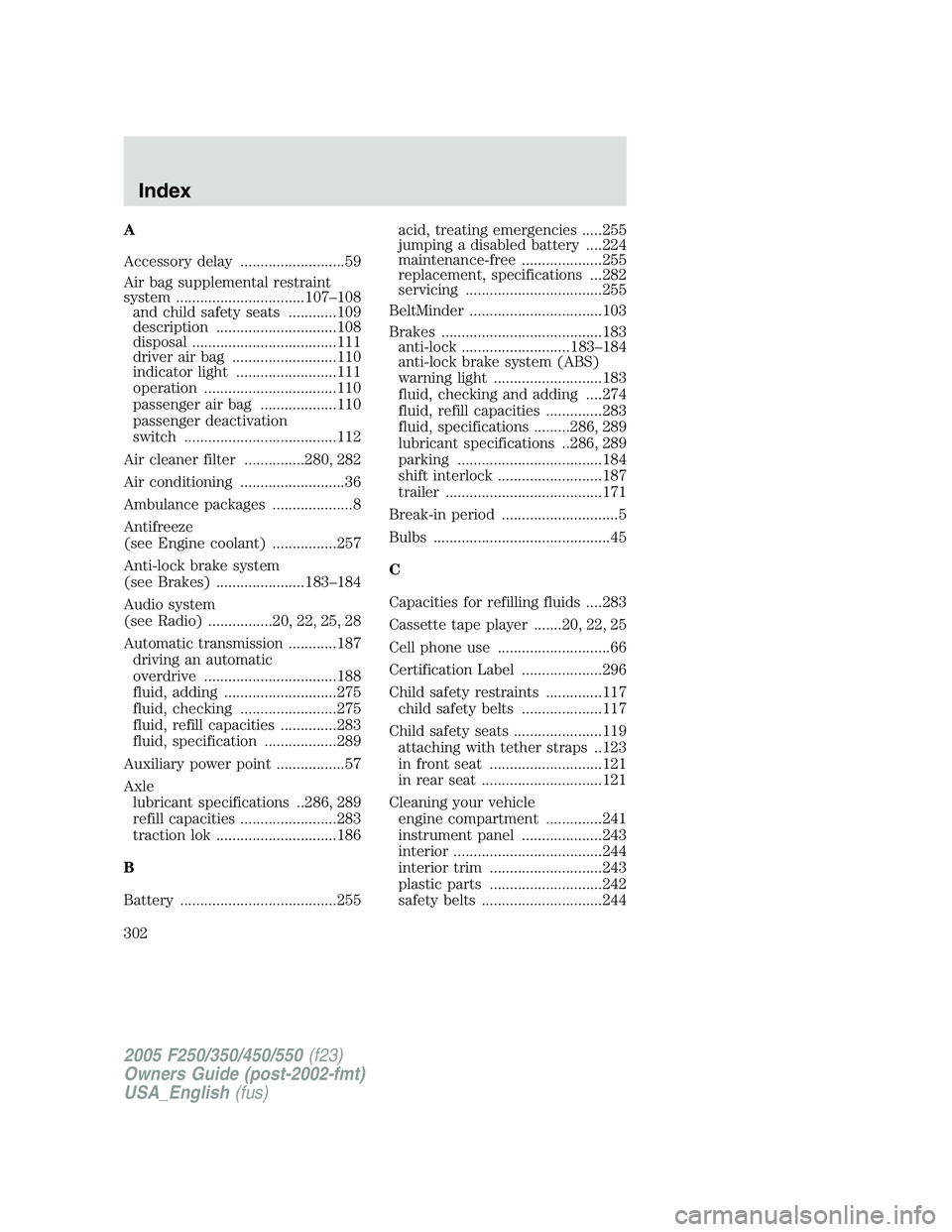
A
Accessory delay ..........................59
Air bag supplemental restraint
system ................................107–108
and child safety seats ............109
description ..............................108
disposal ....................................111
driver air bag ..........................110
indicator light .........................111
operation .................................110
passenger air bag ...................110
passenger deactivation
switch ......................................112
Air cleaner filter ...............280, 282
Air conditioning ..........................36
Ambulance packages ....................8
Antifreeze
(see Engine coolant) ................257
Anti-lock brake system
(see Brakes) ......................183–184
Audio system
(see Radio) ................20, 22, 25, 28
Automatic transmission ............187
driving an automatic
overdrive .................................188
fluid, adding ............................275
fluid, checking ........................275
fluid, refill capacities ..............283
fluid, specification ..................289
Auxiliary power point .................57
Axle
lubricant specifications ..286, 289
refill capacities ........................283
traction lok ..............................186
B
Battery .......................................255 acid, treating emergencies .....255
jumping a disabled battery ....224
maintenance-free ....................255
replacement, specifications ...282
servicing ..................................255
BeltMinder .................................103
Brakes ........................................183
anti-lock ...........................183–184
anti-lock brake system (ABS)
warning light ...........................183
fluid, checking and adding ....274
fluid, refill capacities ..............283
fluid, specifications .........286, 289
lubricant specifications ..286, 289
parking ....................................184
shift interlock ..........................187
trailer .......................................171
Break-in period .............................5
Bulbs ............................................45
C
Capacities for refilling fluids ....283
Cassette tape player .......20, 22, 25
Cell phone use ............................66
Certification Label ....................296
Child safety restraints ..............117
child safety belts ....................117
Child safety seats ......................119
attaching with tether straps ..123
in front seat ............................121
in rear seat ..............................121
Cleaning your vehicle
engine compartment ..............241
instrument panel ....................243
interior .....................................244
interior trim ............................243
plastic parts ............................242
safety belts ..............................244
2005 F250/350/450/550 (f23)
Owners Guide (post-2002-fmt)
USA_English (fus)Index
Index
302